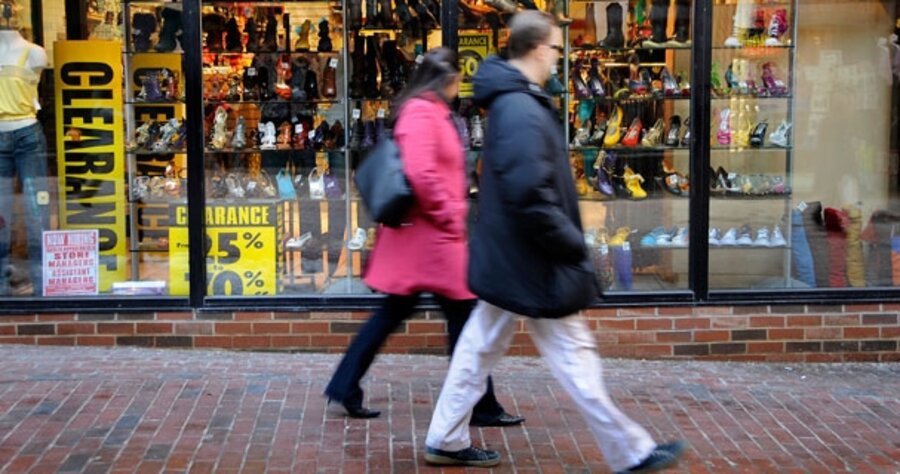Stimulus may soften, not end, recession
Loading...
| Washington
President Obama’s mammoth stimulus plan may be the largest single bill Congress has ever considered. But that doesn’t mean it will solve all the economic problems facing the US.
The nation is mired in one of its worst recessions, and is likely to shed so many jobs and so much business production that even an unprecedented jolt of government spending wouldn’t by itself be able to replace the losses.
In a best-case scenario, by the end of 2010 the recovery package would plug about half the gap between actual Gross Domestic Product and what the GDP would be if the economy were healthy, according to the Congressional Budget Office. The corresponding unemployment rate might be 6.8 percent, in CBO’s judgement – two percentage points lower than it otherwise would have been.
“So even with a [stimulus] package of that size, there’s still a substantial shortfall in economic activity relative to what we could be doing,” said CBO director Douglas Elmendorf in Jan. 27 testimony before Congress.
With the Senate set to take up the stimulus bill this week, Mr. Obama is stepping up his efforts to win bipartisan support for the $800 billion-plus legislation. The House of Representatives passed its version of the stimulus package on Jan. 28 without a single Republican vote.
Since his Jan. 20 inauguration, the new chief executive has wooed Republicans by visiting Capitol Hill for private sessions and inviting them to the White House for consultations.
On Sunday, Obama hosted a bipartisan group of lawmakers for a Super Bowl party.
In his Jan. 31 radio and video address to the nation, Obama argued that the bill is necessary because it would create 3 million jobs, as well as make downpayments on needed investments in healthcare, education, and infrastructure.
But economic recovery will take years, not months, said Obama. “No one bill, no matter how comprehensive, can cure what ails our economy,” he said.
Republicans have pledged to work with Obama as he tries to fulfill his campaign pledge of bipartisanship.
But the GOP remains opposed to much of the spending contained in the economic recovery package. The bill is part stimulus, part long-term reshaping of US domestic spending, many Republicans complain.
The plan “falls far short of the president’s vision for a bill that creates jobs and puts us on a path to long-term economic health,” said Senate minority leader Mitch McConnell in the GOP’s own weekly radio address.
The stimulus bill contains, among other things, $82 billion in tax cuts for individuals, as well as $90 billion in aid for Medicaid programs, $80 billion for a State Stabilization Fund, and $49 billion for energy and water programs.
Its total cost is now over $800 billion and could top $1 trillion by the time the Senate finishes with it.
Large as it is, the proposed legislation would not by itself reverse the current economic downturn, according to Mark Zandi, chief economist of Moody’s Economy.com.
That doesn’t mean he opposes it. The bill “will provide a vital boost to the flagging economy,” Mr. Zandi told the House Budget Committee on Jan. 27.
Zandi agrees that the bill will create 3 million jobs. Without it, the unemployment rate would rise into the double digits – and not sink to 5 percent, the level economists consider full employment, until 2014.
Absent a stimulus package the economy would contract by 3.4 percent for 2009, according to Zandi’s figures. If the bill passes, the GDP would shrink 2.48 percent.
Without a stimulus, the recession would continue into 2010, with further GDP contraction of 1.4 percent. With it, the economy would stabilize next year, in Zandi’s view, and end 2010 in positive growth.
“The stimulus will not keep the downturn from becoming the worst since the Great Depression, but it will ensure that it remains a recession and not a depression,” concludes a Moody’s Economy.com analysis.
A slightly different way of viewing the stimulus is to judge how well it would close the gap between the nation’s potential GDP and its actual performance, according to CBO’s Mr. Elmendorf.
The potential GDP is the level at which the US would be producing if the nation was at full employment, its capital resources were fully engaged, and factories and offices were working on an even keel. The actual GDP is what really happens.
Without a stimulus, the gap between the two would be almost $1 trillion in 2009, and another $1 trillion in 2010, according to CBO figures. It would remain substantial into 2011.
CBO’s best-case scenario shows the stimulus package plugging about half that gap in 2009 and 2010 – that is, adding about $500 billion to real economic activity both years.
Even with the bill, according to CBO, the gap remains large in 2011 and beyond. Thus, “you don’t really want to have a policy that provides a lot of stimulus in 2010, and then goes away overnight,” Elmendorf told lawmakers.
How the government finances the continued spending is another issue – one that many fiscal conservatives are raising.
“We have not yet reached the point where skyrocketing debt levels have caused heightened concerns among investors in US Treasuries. If [Congress] wishes to avoid testing those waters, it should consider tying stimulus efforts with genuine steps toward long-run deficit reduction,” Kevin Hassett, director of economic policy studies at the American Enterprise Institute, told Congress Jan. 27.





